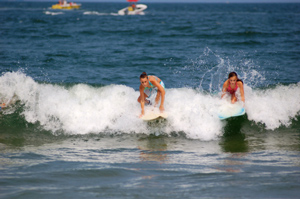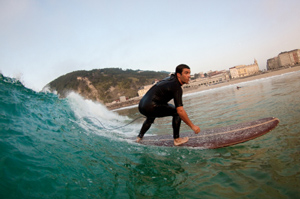Learning to Surf
March 22, 2010


Although a seasoned surfer can make the sport appear as simple as riding a bike, in reality, learning to surf is extremely difficult. Knowledge of the ocean and its waves, as well as lightning-fast reflexes, cat-like balance, and enormous strength are all required to become a great surfer. But don’t let the challenge stop you -- learning to surf isn’t all that tough. With a little patience and persistence, you’ll soon be gliding across the ocean and feeling what Hawaiians call “hopupu”: The state of being stoked. Here are the basics you should know before you paddle out:
The Board Room
Before you head to the beach and hit the waves, it’s important to choose a beginner-friendly surfboard. Hopping onto a high-performance shortboard, for example, will only leave you tired, frustrated, and discouraged. A good rule of thumb for a beginner board is that it is long, wide, and preferably soft. A board somewhere between eight and nine feet long for an average-size adult should be fine. Children under five feet can go a foot or two shorter.
Soft tops, or “foamies,” are great beginner boards because they’re safe for both you and other surfers in the water – should a collision occur, that is. Soft tops are nice and stable and will maximize your chance of getting to your feet and ultimately riding a wave. A longboard shape will also give you ample paddling power, which is an essential part of being able to catch waves.
Hot Tip: On a Leash
Although many seasoned surfers don’t use a leash in moderate to small surf, beginners should definitely use a leggie. A lost board careening toward the beach is not only a nuisance to the person swimming after it, but also becomes a hazard to other surfers in the water. Make sure the leash is securely attached to the rear of the surfboard and then wrap it around your back leg.
Picking an Appropriate Surf Spot
Once you have selected a surfboard, it’s a good idea to understand the basic etiquette of surfing. Remember, the ocean is a dynamic and potentially dangerous place, so the better you understand the rules and customs of the sport, the more you can enjoy its immeasurable rewards.
First, you need to pick a surf spot that matches your ability. As a beginner, you should generally try and find a large, open-beach break that is frequented by beginners to allow yourself plenty of room in the water. One of the golden rules for the beginner surfer is to avoid getting in the way of other surfers. If you’re not sure where a good beginner spot is located in your area, play it safe and ask somebody at a surf shop – or just check out the “Surf Spot Finder” on iSport! It’s crucial to start your surfing life at a beach that will allow you to comfortably hone your skills so you can be safe and have fun.
Paddling 101
Your first challenge as a beginning surfer will be paddling out to the area just beyond where the waves are breaking. This area is commonly referred to as the “lineup.” The golden rule during the paddle out is to avoid colliding with other surfers. Sounds simple, but negotiating a crowd with a large awkward object like a surfboard can present a great challenge. There are few basic guidelines for paddling technique:
- Your body should be positioned in the center of the board, with your weight distributed evenly throughout the board. The tip (or nose) of the surfboard should be no more than an inch or two out of the water. The more surface area of the board that touches the water, the faster you’ll be able to paddle.
- Keep your legs and feet close together. Don’t let your legs hang off the side of the board, as this will compromise stability and create drag.
- When paddling, bend your arms to create a 90-degree angle, similar to a swim stroke. Keep your elbows high and try to pull as much deep water as possible.
- Keep your chest up. Don’t lay flat on the board, as this will severely hamper your paddling power.
Get On Up
Ok, so you’re comfortable paddling and maneuvering your board. Now comes the tricky part: Surfing.
Once you’ve made it out to the lineup, relax and wait for a wave. You may want to practice riding your first waves in the white water before you head out to the breaking waves. As you wait for a set to approach, keep these etiquette points in mind.
- The first surfer on a wave gets that wave. If a surfer is already on a wave, do not “drop in” in front of him/her.
- The surfer closer to the peak (or place where the wave is breaking) always has rights to that wave.
- Don’t immediately paddle out to the top of the lineup. Be respectful and wait your turn.
Once you’ve waited patiently for a wave of your own, it’s time for action. As the wave approaches, turn the nose of your board towards the beach and begin paddling. Your goal at this point is to catch the wave. Paddle hard, only stopping once you’ve felt the wave’s energy moving you and your surfboard. Once you’ve caught the wave, you should be able to stop paddling, since the wave itself is powering you toward the beach. Now you’re ready for the push up, as described in these five steps.
- Determine when you’re ready to push up. Once you feel the wave’s power pushing you forward on its own, you can stop paddling.
- Keeping your chest high, place your hands in a push-up position near the side, or rails, of the surfboard.
- Do a push up. Your arms should now be fully extended.
- Pop up to your feet. In one swift motion, move your hips under your body, putting your front foot forward as you get to your feet. Keep your legs bent.
- With your legs bent and your feet at least shoulder width apart, you should now be up on the board. Try to stand up just behind the middle of the surfboard, towards the tail end.
Hot Tip: Am I Goofy?
To determine if you’re a goofy foot (right foot forward) or a regular foot (left foot forward – also known as a “natural foot”), imagine riding a skateboard or snowboard. Which foot would you put forward? If you still can’t decide, try pushing up on the beach in both positions, and pick the one that feels the most natural.
Making the Drop
Once you’ve mastered popping up to your feet on small waves or just in the white water, you’re ready to take your skills into a proper wave. Dropping in to a wave is a maneuver that varies in difficulty, depending on when you drop in and what type of wave you’re trying to ride. A steeper, hollower wave requires greater skill to drop into. The following three steps are a good basic guideline in learning to negotiate the drop:
- Once you’ve paddled and caught the wave, pop up to your feet and adjust your weight to keep the bottom of the board connected to the breaking wave.
- If the face is steep, keep your weight back in order to prevent the board’s nose from pearling or dipping under the surface.
- Keep your knees bent so they can compress as you drop down the wave face.
Feeling Trim
Trim is the sustained, angled line a surfer takes across a wave face, and for the beginning surfer, nothing is more essential. Because trimming is all about “feeling the glide,” it’s definitely held in higher esteem by longboarders than by shortboarders. For the beginner, however, trimming is a critical skill that will help you master the act of riding a wave. After you’ve completed your drop into the wave and executed a bottom turn that has allowed you to maintain speed, set your inside rail at the angle necessary to keep the wave’s power projecting you across the face. As you slide across the wave face, slight adjustments may be needed to maintain your trim line.
Into the Blue
We’ve now covered all the beginner basics, including what type of surfboard to use, where to learn how to surf, how to catch waves, and how to stand up and ride them. The next phase of your surfing experience is going to take place in one of nature’s most dynamic and challenging arenas: The ocean.

Depending on your experience and comfort level in the ocean, your first few surfing trials will fall somewhere between moderately difficult and next to impossible. Patience and persistence are crucial. Allow yourself the possibility that you may not get a good ride your first time out, and don’t be discouraged if surfing isn’t as easy as the experts make it look. Most importantly, remember that you will improve as you spend more time in the water. Relax, have fun, and get ready for the ultimate stoke!



